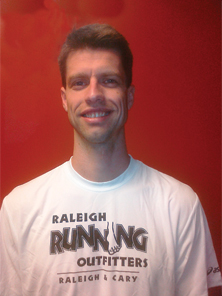Erik Olson is manager and co-owner of the new Raleigh Running Outfitters location in Cary. A former teacher and Web designer, Erik decided to get back to his running roots and open up a specialty running shop with Jim Micheels (owner of Raleigh Running Outfitters in Raleigh). He has been running competitively since the seventh grade, where his first pair of running shoes was Converse All-Stars. He still trains (in better shoes) for half and full marathons. For more information, call (919) 362-8282 or visit www.RaleighRunning.com.
Running Keywords
Pronation is the natural flattening of the arch to absorb impact as the foot strikes the ground. Pronation is completely normal.
Gait is the manner of walking or moving on foot.
EVA midsole is the foam material used in a running shoe.
In Search of the Proper Fit
It’s easy to get lost in front of a giant wall of running shoes at a running store. The running specialists at Raleigh Running Outfitters are trained to guide you through the array of selections and help you achieve the perfect fit.
Understanding the build and typical fit of each running shoe is important. In order to better understand your foot, a personal gait analysis is performed before making any shoe recommendations. By examining your gait as you walk and/or run in our store and by taking a look at the flexibility of your ankles and motion of your feet, we can accurately assess your personal degree of pronation.
Depending on your degree of pronation, one of three types of shoes will be recommended: neutral, stability or motion control. If your arches are generally high and rigid, your gait is considered either neutral or underpronating. You will need neutral shoes. If your arches are flexible and your ankles roll in medially, you are an overpronator and you will need the correction of a stability shoe. If you have an extremely flexible arch and you overpronate severely, then a motion control shoe offering the maximum amount of stability would be recommended.
Expiration Date
Now that you have the right running shoes, how long should you use them before replacing them? The right answer depends on the runner and the shoes because shoes vary greatly in levels of cushioning and runners vary in weight. But generally, training shoes last about 400 miles or six months, whichever comes first. Performance racing shoes, which sacrifice cushioning for a light weight, last about 150–300 miles (or six months).
The shoes have a shelf life because of their EVA midsole, which loses its elasticity after about 6 months. So if you’ve purchased brand-new shoes and stored them in your closet for a period of time, they won’t feel as cushiony out of the box as they once did.
If you run more than 15 miles per week, you may want to track your mileage to determine when you’ll need a new pair of shoes. Beyond that, watch out for achy knees and feet, a sure sign that you are overdue for some fresh cushio






